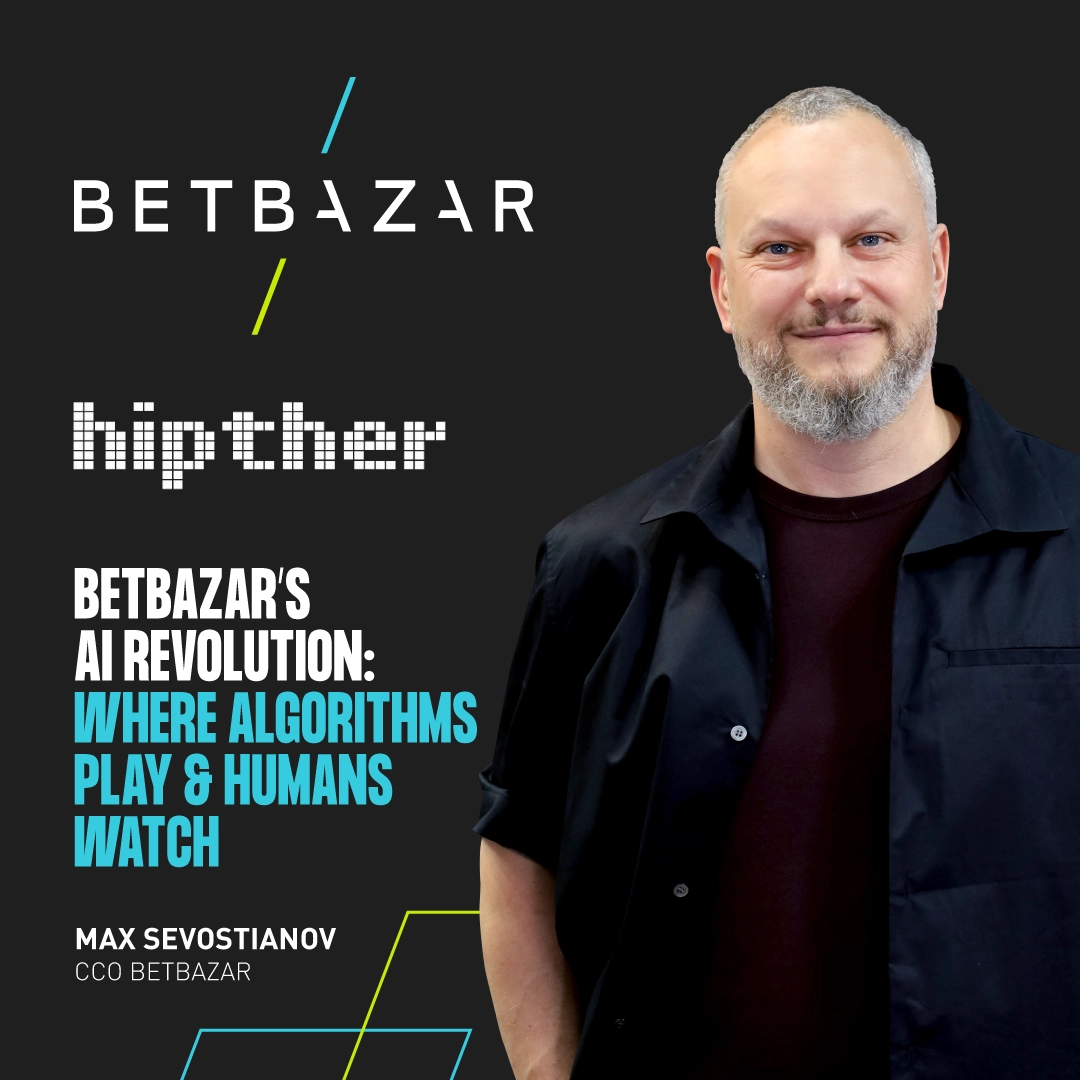
AI Can Shape The Future
iGaming Gazette
With the adoption of artificial intelligence-driven solutions continuing to rise across all major industries, we caught up with BETBAZAR’s COO, Max Sevostianov, to discuss how he sees the technology evolving over the coming months and the main benefits it can provide to businesses.
The increased use of AI has recently been a major development both in iGaming and other industries. Do you think the technology is now here to stay for the long term and what benefits does it offer to operators both in terms of efficiency and customer personalisation?
It’s really hard for me to imagine a world where AI isn’t here to stay for the long term. I think it will continue to play an important developmental role not only in iGaming, but in all major industries; and the fact that it’s being increasingly incorporated by businesses suggest to me that this trend is already well underway.
In terms of what the technology provides, I’d say the benefits are myriad. First and foremost, enhanced efficiency and user personalisation are some of the most striking use cases.
By leveraging AI algorithms, organisations can streamline processes such as customer service, fraud detection and content recommendation, empowering them to deliver a highly personalised experience to their users. Beyond that, I believe the increased adoption of AI also has serious implications for how companies manage their internal processes as well, as it enables them to better analyse the data they have available and improve their integrity features.
For those companies who have not yet incorporated AI systems into their offerings, what considerations need to be made? As AI solutions are only as effective as the data that underpins them, do businesses need to be smarter about how they collect this information?
There are several considerations that need to be made by companies who are yet to incorporate AI systems into their offerings and I think this is definitely one of the key points. As you rightly say, the effectiveness of an AI solution is heavily dependent on the quality and quantity of data available and businesses therefore need to prioritise their data collection to ensure they have access to clean, relevant and diverse data sets.
Additionally, I believe companies must also review their infrastructure – their readiness to incorporate AI, if you will – and ensure that they have things in place such as the necessary computing power and data storage capabilities to support its implementation. Even more fundamentally, however, I think it’s crucial for any organisation to invest in talent with expertise in AI, as having a strong understanding of data science is what will ultimately allow you to develop and manage your AI solutions effectively.
One of the biggest early fears about AI was that it would ultimately replace human input and potentially make some roles redundant. Now that the technology has been here for a few years, would you say these concerns were overblown? Is it more a case of people needing to learn how to work with AI in their roles rather than worrying about it taking over completely?
I think this is a really interesting question because it’s one that always seems to come up whenever a new technology threatens to change our working lives. AI will of course alter and replace human input in certain working processes, but this is a normal thing and certainly nothing to fear.
Throughout our history, advancements in technology and infrastructure have always served as a means to automate processes – but these usually tend to be the processes that are the most repetitive or mechanical. What an AI can’t replace – for now at least! – is human emotion and creativity, so by removing the burden of these more procedurally-driven tasks, we’re actually gaining the freedom to exercise more creativity in our day-to-day work.
I therefore think the focus should be on educating people about how they can add additional value to an AI solution by using their own creative input, rather than worrying about the technology taking things over completely.
We’ve already seen the impact AI can have in automating CRM campaigns and assisting with responsible gambling regulations, but does the technology’s scope also go beyond that in the future? In your opinion, what are the other main business areas that AI can potentially make a difference and how do you see its usage in the industry evolving in the coming years?
Given the way the technology has developed so far, I believe AI is currently poised to revolutionise several aspects of the iGaming industry in the not-so-distant future. These include a few of the things we’ve already touched on like customer acquisition and retention, crowd detection and regulatory compliance, but also aspects such as game development and predictive analytics.
AI can be used to provide valuable insights into player behaviour that enable operators to optimise their marketing strategies, while also allowing them to tailor the gaming experience to the preferences of individual users. Additionally, I believe AI is perfectly suited to driving innovations such as virtual assistants, chat bots and other processes that can be used to improve customer support.
By using the technology in this way, operators can guarantee their customers get the fastest and most accurate response possible, while also reducing the manual workload required.
A Betbazar — parte da holding JKR Invest — visa capacitar sua equipe de vendas com um gerente de vendas júnior/consultor de pré-vendas. Oferecemos o cargo de nível básico em tempo integral com um agendamento remoto opcional para um gerente que deseja iniciar uma carreira no setor de iGaming e vendas B2B.
About the Role
We are looking for a charismatic Business Development Manager with deep experience in the sports or esports industry and strong communication skills. The ideal candidate is proactive and thrives in a fast-paced, data-driven environment.
This is a unique opportunity to join a stable and forward-thinking company where you’ll have access to powerful tools, top industry contacts, and a clear path for growth.
Key Responsibilities
- Identify, approach, and close business deals.
- Leverage your network and CRM systems to drive sales and build long-term client relationships.
- Communicate with decision-makers at top-tier companies.
- Lead negotiations.
- Collaborate closely with internal teams and contribute to strategic growth.
- Maintain accountability for pipeline management and performance tracking.
- Stay up-to-date with industry trends and use data to inform your strategy.
Must-Have Qualifications
- 3+ years of proven success in sports or esports business development or sales.
- Fluent in English (Spanish and/or Portuguese are strong advantages).
- Experience using CRM systems and working with large data sets.
- Strong negotiation and networking skills.
- Contacts within top companies in the industry.
- Excellent communication, time management, and problem-solving skills.
- Analytical mindset with the ability to make data-driven decisions.
- Resilience under pressure and a strong team spirit.
Preferred Qualifications
- Based in Europe
- Experience in a single company for more than 1.5 years
- Motivated by success
- Confident personality with a proactive attitude
What We Offer
- Stable income with the potential for high earnings through bonuses and performance-based rewards.
- Access to powerful CRM platforms, professional tools, and industry databases.
- Subscriptions, resources, and the opportunity to attend global conferences and training.
- Company-sponsored participation in top industry conferences — travel, tickets, and arrangements are handled by us.
- Work with a data-driven company that values innovation and growth.
- Supportive, high-performing team culture with a strong focus on professional development.
Work Conditions
- Full-time
- Remote or hybrid format available
- Contract-based engagement
- Performance-based bonuses
Ready to Join a Winning Team?
If you’re looking for a career-defining opportunity in a thriving sector, with all the tools, contacts, and support you need to succeed — apply now and let’s talk.
- Experiência mínima de 1 ano como gerente de vendas B2B, gerente de desenvolvimento de negócios ou similar
- Experiência comprovada em geração de leads, negociações e integração de novos clientes
- Boa compreensão de produtos de jogos, como apostas esportivas, caça-níqueis e cassino ao vivo
- Inglês fluente escrito e oral
Será uma vantagem:
- Plano de fundo de rede pessoal
- Experiência em outras verticais de jogos
- Compreensão dos instrumentos KYC e das ferramentas de marketing (incluindo afiliados)
- Idiomas adicionais (DE, ES, CN, GR, PL)
Nós oferecemos:
- Salário competitivo e sistema de bônus
- Possibilidades de autodesenvolvimento (falar em público, redação comercial, clube de língua inglesa)
- Ambiente aconchegante e produtivo no centro de Kiev
- Horário de expediente flexível
- Viagens de negócios para exposições e conferências relacionadas a jogos





